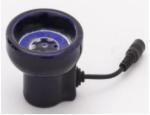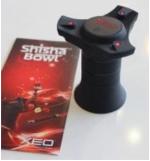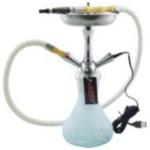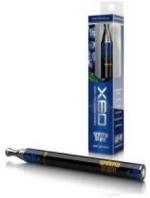Abstract
Introduction
Understanding product development and marketing strategies of transnational tobacco companies (TTCs) has been of vital importance in developing effective tobacco control policy. However, comparatively little is known of the waterpipe tobacco industry, which TTCs have recently entered. This study aimed to gain an understanding of waterpipe tobacco products and marketing strategies by visiting a waterpipe trade exhibition.
Methods
In April 2014 the first author attended an international waterpipe trade exhibition, recording descriptions of products and collecting all marketing items available. We described the purpose and function of all products, and performed a thematic analysis of messages in marketing material.
Results
We classified the waterpipe products into seven categories and noted product variation within categories. Electronic waterpipe products (which mimic electronic cigarettes) rarely appeared on waterpipe tobacco marketing material, but were displayed just as widely. Claims of reduced harm, safety and quality were paramount on marketing materials, regardless of whether they were promoting waterpipe tobacco, waterpipe tobacco-substitutes, electronic waterpipes or charcoal.
Conclusions
Waterpipe products are diverse in nature and are marketed as healthy and safe products. Furthermore, the development of electronic waterpipe products appear to be closely connected with the electronic cigarette industry, rather than the waterpipe tobacco manufacturers. Tobacco control policy must evolve to take account of the vast and expanding array of waterpipe products, and potentially also charcoal products developed for waterpipe smokers. We recommend tobacco-substitutes be classified as tobacco products. Continued surveillance of the waterpipe industry is warranted.
Keywords: waterpipe, industry, marketing, products
INTRODUCTION
Little is known about the product development and marketing strategies of the waterpipe (shisha, narghile, hookah) tobacco industry. This is disconcerting considering national surveys show waterpipe prevalence is over 20% among 13–15 year olds in Lebanon, the West Bank, Estonia, Latvia and the Czech Republic[1]. Although the industry is still in its infancy, London now has an estimated 400 premises serving waterpipe[2]. A study from Lebanon identified that waterpipe industry products are non-compliant with the health warning label and advertising requirements of the WHO FCTC[3] [4].
Recent studies suggest that the alcohol industry has employed political and market strategies similar to those of transnational tobacco companies (TTCs) [5][6, 7], in some cases as a result of co-ownership between tobacco and alcohol industries[8, 9]. This raises important questions about the waterpipe industry strategy considering the recent investment by TTCs in both the waterpipe sector[10] and related industries, including electronic cigarettes (e-cigarettes)[11, 12].
The 1st International Hookah Fair took place in April 2013, and was reportedly visited by over 4,000 delegates from 43 countries. The fair aimed to give “an overview of the great diversity that waterpipes can nowadays offer” and “to develop both business and private contacts”[13]. In April 2014 MJ visited the two day `2nd International Hookah Fair'[13] in Germany. Open to the general public, it attracted 7,133 delegates from 64 countries, and intended to facilitate business-to-business and business-to-customer networking and trade. This second iteration of the exhibition included a `vapour fair'; a trade exhibition for electronic cigarettes. This article documents the product range and marketing strategies from this fair.
METHODS
Sample
Our sample included all exhibitors displaying waterpipe smoking products and related accessories, to whom the researcher introduced himself as a student writing a dissertation on the waterpipe industry.
Data collection
We sequentially attended each exhibition stand according to its assigned stand number, recording information by observation, collection and discussion. Without a priori product selection criteria, we first ascertained the purpose and function of each waterpipe product through dialogue with exhibitors. Informed consent was not sought in order to protect the researcher from unknown threats of disclosure as a tobacco-control researcher. We took field notes and photographed all products at each exhibition stand. No covert audio/video recording took place and field notes contained no identifiable data. Secondly we asked for and collected all available marketing materials. This study was approved by the Imperial College Research Ethics Committee.
Data analysis
We categorised product data as follows: waterpipe consumption products (tobacco, tobacco-substitutes), waterpipe accessories (apparatuses, charcoals, other), electronic waterpipes, and other products. We classified `e-liquids', the substance found in e-cigarettes [14] under “other products”. We described each products' purpose and function.
Using the product categorisation scheme we conducted a content analysis on each marketing item, recording the main product advertised, as well as any other products. One researcher thematically analysed all marketing items using Braun's six phases[15]. We took a theoretical perspective deductively from studies reporting on e-cigarette and waterpipe advertisements [16] [17]. We appropriately weighted contradictory data against the majority message.
RESULTS
Setting
The fair was divided into three areas: the hookah fair (ground floor), shisha lounge (first floor) and vapour fair (second floor). A promotional video was posted shortly after the fair [18]. There were 43 exhibitors in the hookah fair and 54 in the vapour fair. Delegates sampled products in the shisha lounge.
Waterpipe consumption products
Tobacco
All brands were flavoured, and sold either as prepared (tobacco mixed with molasses) or unprepared tobacco (loose/dry containers of tobacco with bottles of molasses sold separately). Both types of waterpipe tobacco are used in the same way; packed into the head of the smoking apparatus and covered with pierced aluminium foil.
Tobacco-substitutes
All brands were flavoured, claiming to contain no tobacco and encompassing different types of product. These included `steam stones' (flavoured synthetic stones[19]), `shisha fruits' (chemically processed pieces of fruit[20]) and `hookah gels' (flavoured paste[21]). Waterpipe tobacco-substitutes were used in the same way as waterpipe tobacco.
Waterpipe accessories
Apparatuses
These greatly differed in size (18 to 78 centimetres in height) and decoration. The number of possible hose attachments ranged from one to four. Several expensive, `limited edition' apparatuses, made specifically for the exhibition, were on display.
Charcoals
Three main types of charcoal included ordinary charcoal briquettes, charcoals briquettes made from coconut shell or bamboo, and quick-lighting charcoal discs. All three types were intended to be ignited and placed above pierced aluminium foil in waterpipe apparatuses to heat the underlying tobacco.
Other
Other waterpipe accessories included a range of charcoal ignition devices (small grills), plastic containers filled with packets of ice which surround a portion of the hose in order to cool down the smoke, and “harm reduction” products such as disposable waterpipe hoses and mouthpiece filters.
Electronic waterpipes
These could be classified into five sub-categories based on Table 1. Electrically-heated ceramic waterpipe heads replace charcoal as the heating element, and the waterpipe is used in the conventional way.
Table 1.
Electronic waterpipe products found at the 2nd International Hookah Fair, Frankfurt, April 2014
| Product | Example image | Uses e-liquids | Uses tobacco | Affixed to a standard waterpipe apparatus | Uses water in the base of the apparatus | Smoke travels through the whole apparatus | Similarity to electronic cigarettes |
|---|---|---|---|---|---|---|---|
| Electrically-heated ceramic waterpipe head |
 1
1
|
No | Yes | Yes | Yes | Yes | No obvious similarity |
| Electronic waterpipe head |
 2
2
|
Yes | No | Yes | No | Yes | The head of the apparatus uses a cartomiser |
| Electronic waterpipe apparatus |
 3
3
|
Yes | No | Yes | No | No | End of the hose appears identical to an electronic cigarette |
| Shisha pen |
 4
4
|
Yes | No | No | N/A | N/A | Appears identical to an electronic cigarette |
| Shisha hose |
 5
5
|
Yes | No | No | N/A | N/A | Appears identical to, but slightly larger (~12 inches) than an electronic cigarette |
[Date of access for all: 14 October 2014]
Electronic waterpipe heads serve to replace both the charcoal and tobacco by using e-liquids. No water is used in the base of the apparatus. The technology used is similar to e-cigarettes, that is, they use cartomisers (components containing a cartridge to hold e-liquids), and an atomiser to vaporise the e-liquid.
Electronic waterpipe apparatuses contain an e-cigarette-like device at the end of the hose, powered by a battery inside the apparatus or an external power source. Vapour is generated from the end of the hose, as opposed to from the head of the apparatus in an electronic waterpipe head.
`Shisha pens' appear and function identically to e-cigarettes, except the liquids used in them generally do not contain nicotine. `Shisha hoses' are larger devices, approximately 12 inches in length, which work in a similar way. `Shisha hoses' are available in both disposable and refillable product variants.
Other products
Other products found at the exhibition included e-liquids, flavoured cigarettes, flavoured roll-your-own tobacco, cigarette papers (not sold in conjunction with waterpipe products), and bongs (glass devices similar to a waterpipe apparatus, used for recreational drug use).
Marketing items
Characteristics of marketing items
Thirty six exhibitors distributed 52 unique waterpipe-specific marketing items advertising a total of 95 products. The language of marketing items were English only (n=20, 38.5%), mixed English/German (n=15, 28.8%) and German only (n=11, 21.1%). The remainder were in English/Italian/Spanish (n=2), Arabic/English (n=1), Arabic/German (n=1), Dutch/English (n=1) and Arabic/English/German (n=1). Over half of the marketing items were from exhibitors based in Germany (n=29, 55.8%), the remainder from elsewhere in Europe (n=10, 19.2%), the Middle East (n=4, 7.7%), Asia (n=3, 5.8%) and the USA (n=2, 3.8%). The remaining four items (7.7%) had no clear country of origin. References to a website were found on most (n=47, 90.4%) items and links to social media were found on 34.6% (n=18) of items.
Ninety five products were found on 52 marketing items (Table 2). Most marketing items contained only one (n=25, 48.1%) or two (n=18, 34.6%) advertised products. Of 13 `other products' found on marketing items these included e-cigarettes or e-liquids (n=6), bongs (n=3), car accessories (n=1) and candles (n=1). Only 2 (3.8%) of the marketing items had a health warning reference: one on an advertised tobacco product, and the other as a small-print text warning at the foot of an A4 flyer. With the exception of one catalogue from a distributor, no marketing material included both electronic waterpipe products and waterpipe tobacco products.
Table 2.
Products found on marketing material items collected at the 2nd International Hookah Fair, Frankfurt, April 2014
| Main product on marketing material | Found anywhere on marketing material | |||
|---|---|---|---|---|
| n | % | N | % | |
| Electronic waterpipe | 13 | 25.0 | 17 | 17.9 |
| Waterpipe tobacco | 13 | 25.0 | 16 | 16.8 |
| Waterpipe apparatus | 12 | 23.1 | 23 | 24.2 |
| Waterpipe tobacco substitute | 4 | 7.7 | 7 | 7.4 |
| Waterpipe accessory | 3 | 5.8 | 13 | 13.7 |
| Charcoal | 3 | 5.8 | 5 | 5.3 |
| No main product | 2 | 3.8 | - | - |
| Other product | 1 | 1.9 | 13 | 13.7 |
| No product | 1 | 1.9 | 1 | 1.1 |
| TOTAL | 52 | 100.0 | 95 | 100.0 |
Thematic analysis
Fourteen themes were identified and 169 incidences of these themes were coded in 52 marketing items (see Table 3). The most common themes were describing waterpipe as a healthier alternative (n=35, 20.7%), describing its flavours (n=30, 17.8%), describing aspects of safety and quality (n=21, 12.4%) and describing its smell, taste and cleanliness (n=18, 10.7%).
Table 3.
Themes elicited from marketing material collected at the 2nd International Hookah Fair, Frankfurt, April 2014
| Theme | n | % | Example |
|---|---|---|---|
| Healthier alternative | 35 | 20.7 | (see Box 1) |
| Flavours | 30 | 17.8 | ““delicious taste, tempting flavours and thick smoke” (Al Bashayer, waterpipe tobacco company) |
| Safety and quality | 21 | 12.4 | “…its composition is safe for health. This is confirmed by the award of the International Certificate of the Ministry of Health, of the Republic of Poland.” (Carbopol, quick-lighting charcoal company) |
| Smell, taste and cleanliness | 18 | 10.7 | “Better taste & clouds than tobacco” (Beamer Hookah, waterpipe tobacco-substitute company) |
| Industry development | 13 | 7.7 | “The authentic patent-protected mouthpiece design, along with high-quality technology standards inside the e-hookah, guarantee best vapour experience” (XEO International, electronic waterpipe company) |
| Price | 13 | 7.7 | “No need to buy normal coal - this saves money as it works much quicker” (Electric Shisha, electronic waterpipe company) |
| Pack and/or accessories | 8 | 4.7 | “The process of packaging goes through rigorous research and development” (Mahroosh, waterpipe tobacco company) |
| Sexual themes | 8 | 4.7 | Women in bikinis smoking waterpipe (Shiazo, waterpipe tobacco-substitutes company) |
| Brand sharing | 7 | 4.1 | Dud Shisha, Boost and Dutch Shisha all present on same item |
| Smokefree legislation | 4 | 2.4 | “Can be used legally indoors where traditional shishas cannot” (Diamond Mist, electronic waterpipe company) |
| Environment | 4 | 2.4 | “…we take special care about the eco-friendliness of this product. It is made of 100% renewable resources with 0 chemical additives.” (Coco Green, charcoal company) |
| Cosmetic appeal | 3 | 1.8 | “Every Nargilem™ hookah is a unique piece of art, with a hand-blown glass made in some of Europe's finest glass manufacturers and a luxurious, massive metal stem.” (Nargilem, waterpipe apparatus company) |
| Lifestyle | 3 | 1.8 | “The lifestyle product for modern smokers.” (XEO, electronic waterpipe company) |
| Celebrity | 2 | 1.2 | “Johnny Depp does it, along with other celebs like; Bradley Cooper, Leonardo DiCaprio, Stephen Dorff, Katherine Heigl, Cheryl Cole, Robert Pattinson, Kate Moss, Ron Wood, Charlie Sheen, Britney Spears, Paris Hilton, Lindsay Lohan, and others…” (XEO, electronic waterpipe company) |
| TOTAL | 169 | 100.0 |
Vague references to waterpipe as a healthier alternative were consistent between and within product categories (see Box 1), although the comparator product was not specified, begging the question: healthier than what? Both electronic waterpipe companies and waterpipe tobacco-substitute companies substantiated their health claims by comparing their product to waterpipe tobacco products. Charcoal companies that sold coconut shell or bamboo briquettes regularly claimed their product was healthier than traditional charcoal briquettes or quick-lighting charcoal discs.
DISCUSSION
This study gives first insight into the rapidly evolving range of waterpipe industry products, and their associated marketing messages. Waterpipe consumption products, accessories and electronic waterpipe products all promoted harm reduction claims, despite evidence of a harmful toxicological profile of tobacco-substitutes[22, 23] and all types of charcoal[24]. Electronic waterpipe products and waterpipe tobacco products were rarely placed together on the same marketing item. We therefore hypothesise that waterpipe tobacco companies either do not produce electronic waterpipe products, or choose to brand and market them distinctly. Given the similarities, the growing electronic waterpipe market may instead by thought of as an offshoot of the e-cigarette industry.
Implications for policy
Health policy makers should be aware of the expanding range of waterpipe products available, which should be classified in order to facilitate effective legislation. We recommend that electronic waterpipe products containing `cartomisers' or other e-cigarette-like technology should be classified as electronic nicotine delivery systems (ENDS) as opposed to waterpipe tobacco products. The marketing of electronic products as waterpipes may be a marketing tactic to promote e-cigarette devices to a different audience, or to create confusion in current policy debates, thereby slowing the move towards a coherent regulatory framework.
We recommend that waterpipe tobacco-substitutes be classified as tobacco products due to the known chemical composition of smoke it produces [22, 23], the fact they are marketed alongside tobacco products, and the observation that products claiming to be tobacco-substitutes may nevertheless contain tobacco[2, 22]. This echoes similar calls for paan and paan masala (local forms of chewed tobacco inherent to south Asia) to be considered smokeless tobacco products, even if they do not contain tobacco[25].
Considering the marketing claims of charcoal companies may directly promote the use of tobacco, these should also be addressed in a regulatory framework.
Implications for research
The vast array of product categories, as well as variations within these categories, may complicate tobacco surveillance. For example, participants completing tobacco surveys may confuse `shisha pens' (a form of e-cigarette) with `shisha' (traditional waterpipe). Validated survey questions must make these differences clear.
More research about the waterpipe tobacco and electronic waterpipe industries is warranted, including studies of its structure, ownership and the potential effects of its expansion in terms of the larger tobacco product universe.
Additional research may seek to contextualise current entreaties by the tobacco industry into the waterpipe market by examining their historical interest in this field. The Legacy Tobacco documents library provides a valuable resource for examining past developments in this area.
Strengths and limitations
To our knowledge this is the first study to provide insight into a waterpipe trade exhibition. We systematically collected product information and marketing items, and analysed them using a methodological marketing framework consistent with previous studies. As a descriptive, thematic study with a limited sample coded by one researcher, no generalizable conclusions can be drawn.
Conclusions
This trade exhibition featured a range of waterpipe products, mainly marketed as healthy and safe. Electronic waterpipe products should be considered as part of the wider e-cigarette category, not as part of the waterpipe industry. Policymakers should develop a robust legal framework addressing waterpipe.
WHAT THIS PAPER ADDS.
What is already known on the subject
Understanding the modus operandi of cigarette companies, especially product development and marketing strategies, can inform tobacco control policy;
One cigarette company recently purchased the second largest waterpipe tobacco company;
Waterpipe prevalence is growing worldwide and their industry products are generally non-compliant with tobacco control policy.
What important gaps in knowledge exist on this topic
Little is known about the products and marketing strategies of the waterpipe tobacco industry;
There is a lack of understanding about effective waterpipe tobacco interventions and policy regimes;
Unlike for cigarette companies, researchers do not have access to the secret internal documents of waterpipe tobacco companies.
What this study adds
We are able to categorise waterpipe products and hypothesise that electronic waterpipe products are highly similar to electronic cigarettes, with manufacturers closely connected to electronic cigarette industry;
We show that claims of reduced harm are present on marketing material across tobacco, tobacco-substitute, electronic and charcoal companies.
Box 1: Waterpipe as a healthy product.
“…our goal is to have our patrons with not only the best but the healthiest forms of smoking hookah.” (Mahroosh, waterpipe tobacco company)
“…it is possible to enjoy your shisha without tobacco and side effects like nicotine or tar…” (Shiazo, waterpipe tobacco-substitute company)
“Besides the convenient usage and the health benefits there are many more advantages of using Shiazo as an alternative for tobacco.” (Shiazo, waterpipe tobacco-substitute company)
“Shisha Fruit contains no tobacco and no nicotine and is therefore less harmful to use.” (Shisha Fruit, waterpipe tobacco-substitute company)
“The safer shisha experience.” (Diamond Mist, electronic waterpipe company)
“less ash, no fumes, no smell, low emissions” (Tom Cococha, charcoal company)
“does not contain any chemical substances like you would find them in quick lighting charcoal.” (Cocobrico, charcoal company)
ACKNOWLEDGEMENTS
Dr. Hawkins' research was partially supported by the National Cancer Institute of the National Institutes of Health under award number R01CA091021. The content is solely the responsibility of the authors and does not necessarily represent the official views of the National Institutes of Health.
FUNDING This study was funded by the Clinical Research Institute at the American University of Beirut.
Footnotes
CONFLICTS OF INTEREST None
AUTHOR CONTRIBUTION MJ, EAA and RN conceptualised the study and drafted the study protocol. MJ collected data. MJ and BH performed data analysis. MJ wrote the first draft of the manuscript. All authors read and approved the final version of the manuscript.
REFERENCES
- 1.Jawad M, Lee JT, Millett C. Waterpipe tobacco smoking prevalence and correlates in 25 Eastern Mediterranean and Eastern European countries: cross-sectional analysis of the Global Youth Tobacco Survey. Nicotine Tob Res. 2015 doi: 10.1093/ntr/ntv101. [DOI] [PubMed] [Google Scholar]
- 2.Jawad M. Legislation enforcement of the waterpipe tobacco industry: a qualitative analysis of the London experience. Nicotine Tob Res. 2014;16(7):1000–8. doi: 10.1093/ntr/ntu022. [DOI] [PubMed] [Google Scholar]
- 3.Nakkash R, Khalil J. Health warning labelling practices on narghile (shisha, hookah) waterpipe tobacco products and related accessories. Tob Control. 2010;19(3):235–9. doi: 10.1136/tc.2009.031773. [DOI] [PMC free article] [PubMed] [Google Scholar]
- 4.Khalil J, Heath RL, Nakkash RT, et al. The tobacco health nexus? Health messages in narghile advertisements. Tob Control. 2009;18(5):420–1. doi: 10.1136/tc.2009.030148. [DOI] [PubMed] [Google Scholar]
- 5.Gordon R, MacKintosh AM, Moodie C. The Impact of Alcohol Marketing on Youth Drinking Behaviour: A Two-stage Cohort Study. Alcohol Alcohol. 2010;45(5):470–80. doi: 10.1093/alcalc/agq047. [DOI] [PubMed] [Google Scholar]
- 6.Casswell S. Current status of alcohol marketing policy—an urgent challenge for global governance. Addiction. 2012;107(3):478–85. doi: 10.1111/j.1360-0443.2011.03701.x. [DOI] [PubMed] [Google Scholar]
- 7.McCambridge J, Hawkins B, Holden C. Vested Interests in Addiction Research and Policy. The challenge corporate lobbying poses to reducing society's alcohol problems: insights from UK evidence on minimum unit pricing. Addiction. 2014;109(2):199–205. doi: 10.1111/add.12380. [DOI] [PMC free article] [PubMed] [Google Scholar]
- 8.Bond L, Daube M, Chikritzhs T. Access to confidential alcohol industry documents: from `Big Tobacco'to `Big Booze'. Australasian Medical Journal. 2009;1(3):1–26. [Google Scholar]
- 9.Bond L, Daube M, Chikritzhs T. Selling addictions: similarities in approaches between Big Tobacco and Big Booze. World Healthcare Providers. 2010;1(3) [Google Scholar]
- 10.Jawad M. Japan Tobacco Inc expands into shisha. Tobacco Control. 2013;22:81. [Google Scholar]
- 11.Gara T. [access 15 January 2015];More E-Cigarettes in the Hands of Big Tobacco. The Wall Street Journal. 2014 [online] Available at: http://blogs.wsj.com/corporate-intelligence/2014/02/03/more-e-cigarettes-in-the-hands-of-big-tobacco/
- 12.Tobacco Tactics [access 22 January 2015];E-cigarettes. 2014 [online]. Available at: http://www.tobaccotactics.org/index.php/E-cigarettes.
- 13.Projekt20drei10 [access 13 January 2015];Exhibitor Info. 2014 [online] Available at: http://hookahfair.com/index.php/en/exhibitor-info/exhibitor-info.
- 14.Etter J-F, Zäther E, Svensson S. Analysis of refill liquids for electronic cigarettes. Addiction. 2013;108(9):1671–9. doi: 10.1111/add.12235. [DOI] [PubMed] [Google Scholar]
- 15.Braun V, Clarke V. Using thematic analysis in psychology. Qual Res Psychol. 2006;3(2):77–101. [Google Scholar]
- 16.Andrade Md, Hastings G, Angus K. Promotion of electronic cigarettes: tobacco marketing reinvented? BMJ. 2013;347:f7473. doi: 10.1136/bmj.f7473. [DOI] [PubMed] [Google Scholar]
- 17.Sterling KL, Fryer CS, Majeed B, et al. Promotion of waterpipe tobacco use, its variants and accessories in young adult newspapers: a content analysis of message portrayal. Health Educ Res. 2015;30(1):152–61. doi: 10.1093/her/cyu035. [DOI] [PMC free article] [PubMed] [Google Scholar]
- 18.YouTube [access 22 January 2015];ShishaMesse | HookahFair | VaporFair - 2014 HQ. 2014 [online]. Available at: https://www.youtube.com/watch?v=jziWu-Vsrz8.
- 19.Shiazo [access 22 January 2015];Shiazo: The original steam stones. 2015 [online]. Available at: http://www.shiazo.com.
- 20. [access 22 January 2015];Shishafruits. 2015 [online]. Available at: http://vaporfruits.com/
- 21. Hookah-Shisha.com [access 22 January 2015];Beamer Hookah Gel Ice Drops - 50g Jar. 2015 Hookah-Shisha.com [online]. Available at: https://www.hookah-shisha.com/p-14578-beamer-hookah-gel-ice-drops.html.
- 22.Hammal F, Chappell A, Wild TC, et al. `Herbal' but potentially hazardous: an analysis of the constituents and smoke emissions of tobacco-free waterpipe products and the air quality in the cafes where they are served. Tob Control. 2013 doi: 10.1136/tobaccocontrol-2013-051169. [DOI] [PubMed] [Google Scholar]
- 23.Shihadeh A, Salman R, Jaroudi E, et al. Does switching to a tobacco-free waterpipe product reduce toxicant intake? A crossover study comparing CO, NO, PAH, volatile aldehydes, “tar” and nicotine yields. Food Chem Toxicol. 2012;50(5):1494–8. doi: 10.1016/j.fct.2012.02.041. [DOI] [PMC free article] [PubMed] [Google Scholar]
- 24.Sepetdjian E, Saliba N, Shihadeh A. Carcinogenic PAH in waterpipe charcoal products. Food Chem Toxicol. 2010;48(11):3242–5. doi: 10.1016/j.fct.2010.08.033. [DOI] [PMC free article] [PubMed] [Google Scholar]
- 25.Mukherjea A, Modayil MV, Tong EK. Paan (pan) and paan (pan) masala should be considered tobacco products. Tob Control. 2014 doi: 10.1136/tobaccocontrol-2014-051700. [DOI] [PubMed] [Google Scholar]


